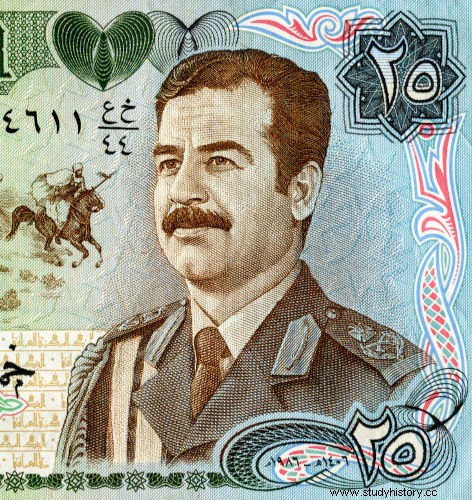Saddam Hussein was marked in the history of the 20th century as an Iraqi dictator who assumed the presidency of his country in 1979. Hussein started two wars, committed a crime against humanity by using chemical weapons against the Kurds, and was deposed from power when Iraq was invaded by troops in 2003.
Go to also :Pol Pot, the Cambodian Tyrant
Youth
Saddam Hussein Abd al-Majid al-Tikriti was born on April 28, 1917, in a village called Al-Auja, a few kilometers from Tikrit, a city located in northern Iraq.

Saddam Hussein's childhood was complicated because he didn't arrive to meet his father, Hussein Abid al-Majid . Some sources say that he died, during the fourth month of his son's pregnancy, of cancer. However, other sources allege that he may have abandoned his family.
The situation worsened because his mother, Subha Tulfah al-Mussallat , suffered from severe depression during her pregnancy . This happened because, in addition to losing her husband, she lost her eldest son, also a victim of cancer. Because of this, she would have attempted to abort and commit suicide , but was unsuccessful in both actions.
When Hussein was born, he was reportedly rejected by his mother, so he was in the care of his uncle, Khairullah Tulfah . The uncle would have been his paternal reference and given all the necessary care for his upbringing. Tulfah was also an essential figure for Hussein's access to education and for him to enter politics.
Political militancy
At age 20, Saddam Hussein dropped out of school in Baghdad and joined a party that marked the history of Iraq in the second half of the 20th century. The Ba'ath Party emerged in Syria and arrived in Iraq in the 1950s. With nationalist positions , was against European colonial rule and defended the union of Arab peoples in a great nation.
Hussein joined the party in 1957, and the following year, the Iraqi monarchy was overthrown . The Ba'ath Party took different positions within the new government, a republic. This coup had been led by Abd al-Karim Qasim, who had Ba'ath support.
The Ba'athist's relationship with Qasim turned sour when he refused to accept the unification plans proposed by Gamal Abdel Nasser, the president of Egypt. Nasser's project was to form a great Arab nation that would incorporate the territories of Egypt, Syria and Iraq. Qasim's denial made the Ba'ath his enemy.
With this, the party began to conspire against Qasim's life, and Saddam Hussein was chosen to lead an attack against the life of the Iraqi ruler. Qasim's assassination plan was carried out in October 1959, but was unsuccessful. Because of the failure and risk it posed, Hussein and other Ba'athists had to flee Iraq .
Hussein went to Syria, stayed there for a few months, and then moved to Egypt, where he stayed for three years. His return happened because, in early 1963, a military coup took place in Iraq. Qasim's government was overthrown by a coup led by Abdul Salam Arif .
This coup was supported by the Ba'athists, which allowed those involved in the 1959 bombing to return to Iraq safely. Saddam Hussein was then able to return to Iraq, but that all changed at the end of 1963, as Arif took a self-coup in the country, and Ba'ath support for him ended.
Hussein had to live underground and participated in a failed Ba'athist coup attempt. Arif ordered a persecution against the party, and in the process, Saddam Hussein ended up arrested, in October 1964 . His stay in prison was not very long, as in 1966 he managed to escape.
After jailbreak , Saddam Hussein committed himself to the Iraqi power struggle. He was still a member of the Ba'ath Party, which aimed to take the reins of the country. At the time, the Iraqi president was Abdul Rahman Arif, brother of the former president. At that moment, Saddam Hussein became a very important figure on the Ba'ath boards.
In July 1968, Hussein took part in a coup led by Ahmed Hassan al-Bakr . Through this coup, Arif was exiled to Iraq, and the Ba'ath finally seized Iraqi power. Ahmed al-Bakr became president of Iraq, and Saddam Hussein, the second man in the country .
Login also :Augusto Pinochet, one of the worst dictators in South American history
Saddam Hussein as Dictator
Between 1968 and 1979, Hussein was not the Iraqi president, but during this period, he gained power and prestige for his image. In these more than 10 years, he identified the strong tendency of Iraqi society towards fragmentation and that this increased the country's political instability. This led him to fight any kind of political opposition .
Repression took place both in society and within the Ba'ath Party. He also created a police secret to monitor the Iraqi population and prevent opposition movements from gaining strength. To secure more support, he has invested in the modernization and development of the economy Iraqi.
This strengthened the country's economy, allowing the Iraqi government to provide population benefits that few countries in the region did. On the other hand, Saddam Hussein managed to set up a power structure that allowed him to monitor and crush any initiative that opposition groups outlined. In short, it was an authoritarian government.
In 1979, Saddam Hussein forced Al-Bakr out of the presidency, and thus he officially assumed the presidency iraqi. Hussein was an authoritarian ruler , corrupt and violent . During that period in the presidency, he committed a crime against humanity by using chemical weapons against the Kurdish population that lived in the village of Halabja.
This attack took place in 1988 and was a reprisal by the dictator for the support that the people of this village had given to Iranian troops during the Iran-Iraq War . This conflict was a disaster for his government. Caused over a million deaths , Iran was not defeated, and the Iraqi economy bled from the war expenditures.
Another conflict that Hussein started was the Gulf War , in which Iraq and Kuwait had a falling out over oil issues and debts that the former contracted with the latter during the Iran-Iraq War. The invasion of Kuwait took place in 1990 and mobilized the United States against Iraq.
The US intervention quickly put an end to the Iraqi adventure in Kuwait and forever undermined relations between Iraq and Kuwait.
Login also :Mao Zedong, the leader of the communist revolution in China
Latest years

As mentioned, the relationship between the United States and Iraq, after the Gulf War it remained bad. The terrorist attacks promoted by Al-Qaeda, on September 11, 2001, radically altered the position of the United States in the Middle East. US action in this region has become more interventionist .
As a result, governments hostile to the United States, such as the Iraqi, came to be seen as a major threat and became a target for the Americans. Using the justification of the “war on terror” , the United States began to accuse Iraq of possessing weapons of mass destruction. The US claim was false as Iraq did not have them.
In any case, the US invasion of Iraq took place in early 2003. Saddam Hussein was forced to relinquish power in the country and flee to Baghdad. He remained in hiding for a few months, but was captured by US troops at Ad-Dawr. He was put on trial and convicted of a crime against humanity .
The execution of Saddam Hussein took place on December 30, 2006 , and his death was by hanging .
